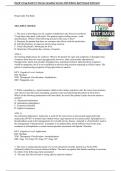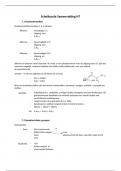David’s Drug Guide For Nurses Canadian Version 16th Edition April Hazard Vallerand
Drug Guide Test Bank
MULTIPLE CHOICE
1. The nurse is providing care for a patient scheduled to take Precose (acarbose)
25 mg three times daily with meals. The patient reports feeling sweaty, weak,
and tremulous. Which of the following actions by the nurse is best?
A. Reassure the patient that these are common side effects with the medication.
B. Call the pharmacy to report an adverse drug reaction.
C. Check the patient’s blood glucose level.
D. Determine if the patient has a history of anemia.
ANS: C
See Nursing Implications for acarbose: Observe the patient for signs and symptoms of hypoglycemia.
Acarbose alone does not cause hypoglycemia; however, other concurrently administered
hypoglycemic agents may produce hypoglycemia, requiring treatment. Ignoring these symptoms
would be dangerous, but it is not considered an adverse drug reaction requiring an official report. The
patient is experiencing symptoms of hypoglycemia not anemia.
KEY: Cognitive Level: Analysis
DIF: Medium
TOP: Therapeutic Classification: Antidiabetics
REF: Drugguide.com
2. While responding to a rapid response called on the cardiac step-down unit, the nurse from intensive
care observes the unit nurse massaging a patient’s neck and instructing the patient to bear down.
Which of the following medications will most likely be used if the patient’s pulse does not return to
normal?
A. Adenocard (adenosine)
B. Adrenaline (epinephrine)
C. Tenormin (atenolol)
D. Saphris (asenapine)
ANS: A
See adenosine Indications: Adenosine is used for the conversion of paroxysmal supraventricular
tachycardia (PVST) to normal sinus rhythm when vagal maneuvers are unsuccessful. Epinephrine is a
bronchodilator used in the management of reversible airway disease. Atenolol is a beta blocker used in
the management of hypertension. Asenapine is an antipsychotic mood stabilizer used in the acute
treatment of schizophrenia or manic/mixed episodes associated with bipolar I disorder.
KEY: Cognitive Level: Application
DIF: Medium
TOP: Therapeutic Classification: Antiarrhythmics
REF: Page 114 | Page 502 | Page 197 | Page 189
3. The nurse is instructing the parent of a 6-year-old patient recently started on a ProAir HFA
(albuterol) inhaler for exercise-induced asthma. The nurse recognizes that further teaching is necessary
by which of the following client statements?
A. “He may feel like his heart is racing after he takes his inhaler.”
,David’s Drug Guide For Nurses Canadian Version 16th Edition April Hazard Vallerand
B. “He can use the inhaler as many times during football practice as he needs it.”
C. “He should avoid cola and other caffeinated drinks since they may increase his heart rate.”
D. “He should take two puffs about 15 minutes before gym class.”
ANS: B
See Contraindications/Precautions, Interactions, and Dosage for albuterol. Excess inhaler use may lead
to tolerance and paradoxical bronchospasm. Use with caffeine-containing herbs (cola nut, guarana, tea,
coffee) increases stimulant effect. Two inhalations every 4–6 hr or two inhalations 15 min prior to
exercise). Tachycardia is an expected side effect with this medication.
KEY: Cognitive Level: Analysis
DIF: Easy
TOP: Therapeutic Classification: Bronchodilators
REF: Page 118
4. While providing care for an adolescent patient newly prescribed Elavil (amitriptyline), the nurse
should be most concerned by which of the following patient statements?
A. “My mouth seems really dry and I’m thirsty all the time.”
B. “I take a nap most afternoons now because I feel sleepy sometimes.”
C. “I’m not sure why we should even bother anymore; everything seems so pointless.”
D. “I drink a cup of coffee most days with breakfast.”
ANS: C
See Contraindications/Precautions for amitriptyline: the use of this medication may increase the risk of
suicide attempt/ideation especially during dose early treatment or dose adjustment; risk may be greater
in children or adolescents. Sedation is an expected side effect. Dry mouth is an expected side effect.
There is no directive to avoid caffeine with this medication.
KEY: Cognitive Level: Analysis
DIF: Medium
TOP: Therapeutic Classification: Antidepressants
REF: Page 145
5. The nurse is caring for a patient with otitis media who reports an allergy to penicillin. Orders are
received for ampicillin 500 mg every 8 hr. Which of the following actions by the nurse is best?
A. Provide the medication as ordered.
B. Call the pharmacist to request a substitution.
C. Ask the patient if he or she has taken ampicillin in the past.
D. Hold the medication.
ANS: D
See contraindications/precautions for ampicillin: Contraindicated in hypersensitivity to penicillin. This
medication should be held due to the stated allergy to penicillin.
KEY: Cognitive Level: Application
DIF: Easy
TOP: Therapeutic Classification: Anti-infectives
REF: Page 158
,David’s Drug Guide For Nurses Canadian Version 16th Edition April Hazard Vallerand
6. While caring for a patient in hospice who is actively dying, the nurse notes moderate respiratory
distress, copious oral secretion, and a frequent moist cough. Which of the following prn medications
would most promote comfort for the patient?
A. Morphine (morphine sulfate) 2 mg IV bolus
B. Atro-Pen (atropine) 0.4 mg IV bolus
C. Ativan (lorazepam) 0.5 mg IV bolus
D. Benadryl (diphenhydramine) 25 mg IV bolus
ANS: B
See Action for atropine: Low doses decrease sweating, salivation, and respiratory secretions.
Morphine is used for pain control. Lorazepam is used for anxiety. Benadryl is used for itching.
KEY: Cognitive Level: Analysis
DIF: Medium
TOP: Therapeutic Classification: Antiarrhythmics | Therapeutic Classification: Anticholinergics
REF: Page 203
7. The nurse is counseling a patient started on Zithromax (azithromycin) for the treatment of an upper
respiratory infection. The nurse recognizes that teaching has been effective by which of the following
patient statements?
A. “The med pack will have five pills, one for each of the next 5 days.”
B. “If I don’t feel better next week, I can get a refill from the pharmacist.”
C. “I only need to take one pill, but my symptoms may not clear for 3 days.”
D. “I can take this medication safely even though I’m allergic to erythromycin.”
ANS: A
See Route/Dosage for azithromycin: 500 mg on 1st day, then 250 mg/day for 4 more days. Instruct the
patent to notify health-care professional if symptoms do not improve. Teach the patient to take
medication as directed and to finish the drug completely. Azithromycin is contraindicated in patients
with an allergy to erythromycin.
KEY: Cognitive Level: Analysis
DIF: Easy
TOP: Therapeutic Classification: Anti-infectives
REF: Page 208
8. The home-care nurse is preparing to see a patient being treated for diabetic foot ulcerations with
Regranex (becaplermin). Which of the following instructions will the nurse include in the patient
teaching?
A. “Apply the wound gel three times daily to promote healing.”
B. “Store the gel in the refrigerator.”
C. “Complete healing is expected within 3 days.”
D. “After applying the wound gel, cover with a transparent adhesive dressing.”
ANS: B
See Implementation for becaplermin: Calculated amount is applied as a thin layer and covered with a
moist saline dressing for 12 hr; dressing is removed, ulcer rinsed, and redressed with moist dressing
without becaplermin for rest of day. Process is repeated daily. Store gel in refrigerator; do not freeze. If
ulcer does not decrease in size by 30% within 10 wk, continuation of therapy should be reassessed.
Cover with a moist saline dressing for 12 hr. Then, remove dressing, rinse ulcer, and redress with
moist dressing without becaplermin for rest of day.
, David’s Drug Guide For Nurses Canadian Version 16th Edition April Hazard Vallerand
KEY: Cognitive Level: Analysis
DIF: Hard
TOP: Therapeutic Classification: Wound/Ulcer/Decubiti healing agents
REF: Page 217
9. The nurse is tracking patient symptoms related to acute alcohol intoxication and withdrawal. Which
of the following medications would the nurse expect to provide in the management of these
symptoms?
A. Plavix (clopidogrel)
B. Zyban (bupropion)
C. Prilosec (omeprazole)
D. Tranxene (clorazepate)
ANS: D
See Indications for clorazepate: Clorazepate is used in the management of simple partial seizures,
anxiety disorder, symptoms of anxiety, and acute alcohol withdrawal. Clopidogrel is an antiplatelet
agent. Bupropion is an antidepressant. Omeprazole is an antiulcer agent.
KEY: Cognitive Level: Application
DIF: Medium
TOP: Therapeutic Classification: Anticonvulsants
REF: Drugguide.com
10. The nurse prepares to provide Colcrys (colchicine) to a patient. The nurse should assess which of
the following prior to administration of the medication?
A. Blood pressure
B. Complete blood count
C. Triglyceride level
D. Oxygen saturation
ANS: B
See Nursing Implications/assessment for colchicine: In patients receiving prolonged therapy, monitor
baseline and periodic CBC; may cause decreased platelet count, leukopenia, aplastic anemia, and
agranulocytosis. No alteration in the blood pressure, triglyceride, or oxygenation is expected.
KEY: Cognitive Level: Application
DIF: Hard
TOP: Therapeutic Classification: Antigout agents
REF: Page 343
11. The nurse is transcribing new orders for a patient with multiple sclerosis. Amrix (cyclobenzaprine)
10 mg orally three times daily has been ordered. Which of the following would require an immediate
intervention by the nurse?
A. The patient has a noted allergy to acetaminophen.
B. The patient has a family history of breast cancer.
C. The patient is currently taking Nardil (phenelzine).
D. The patient is diabetic.





